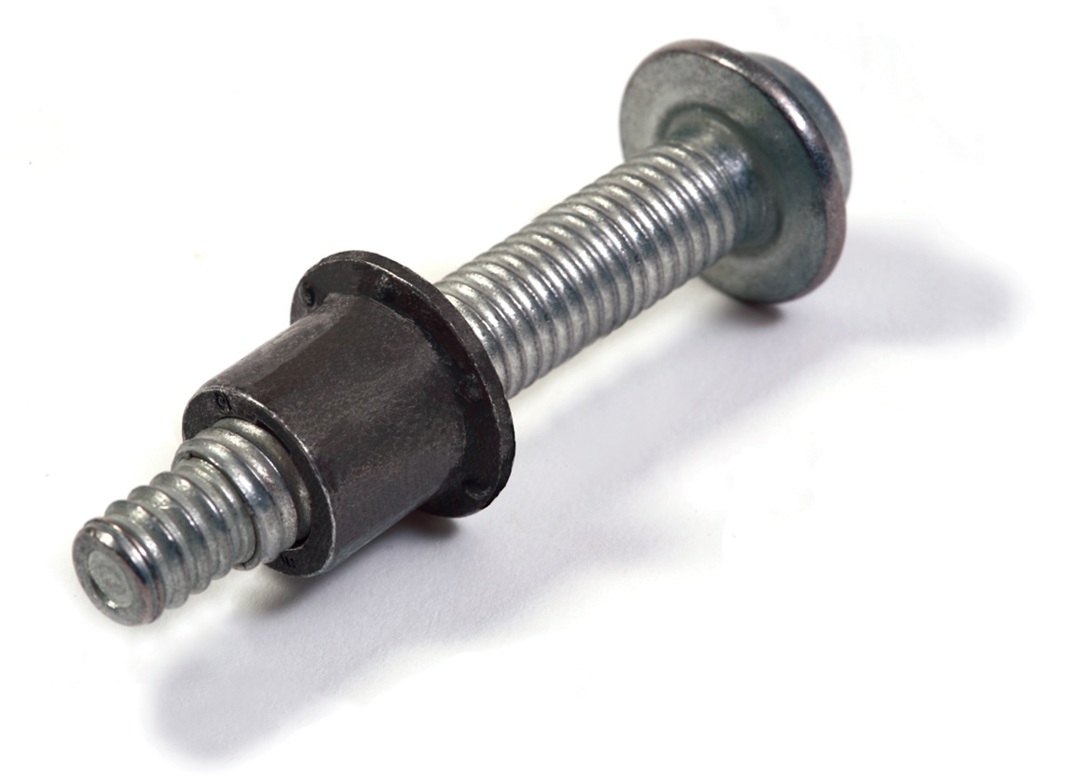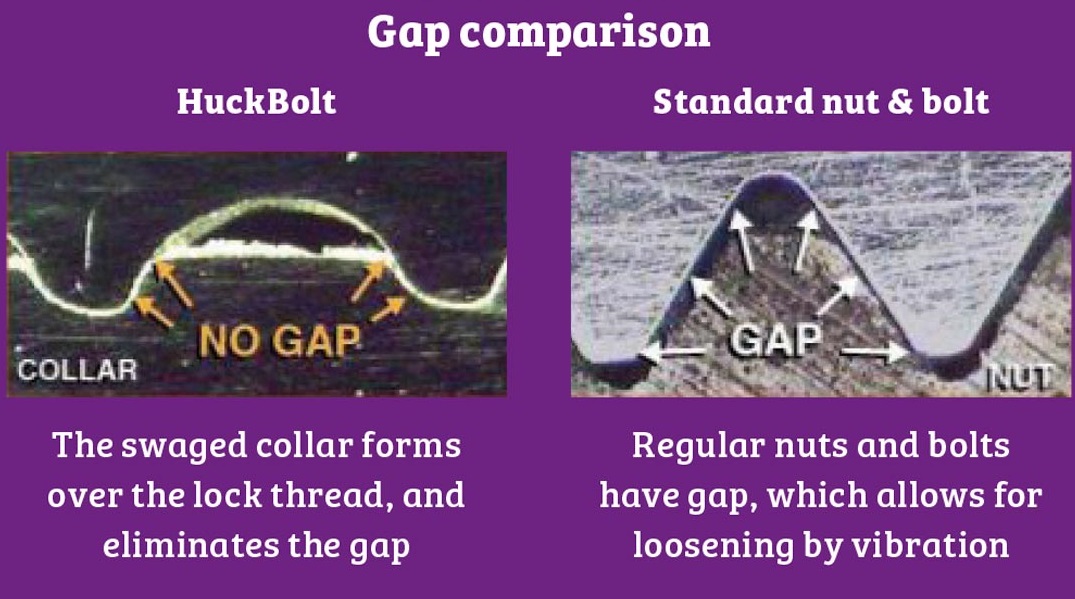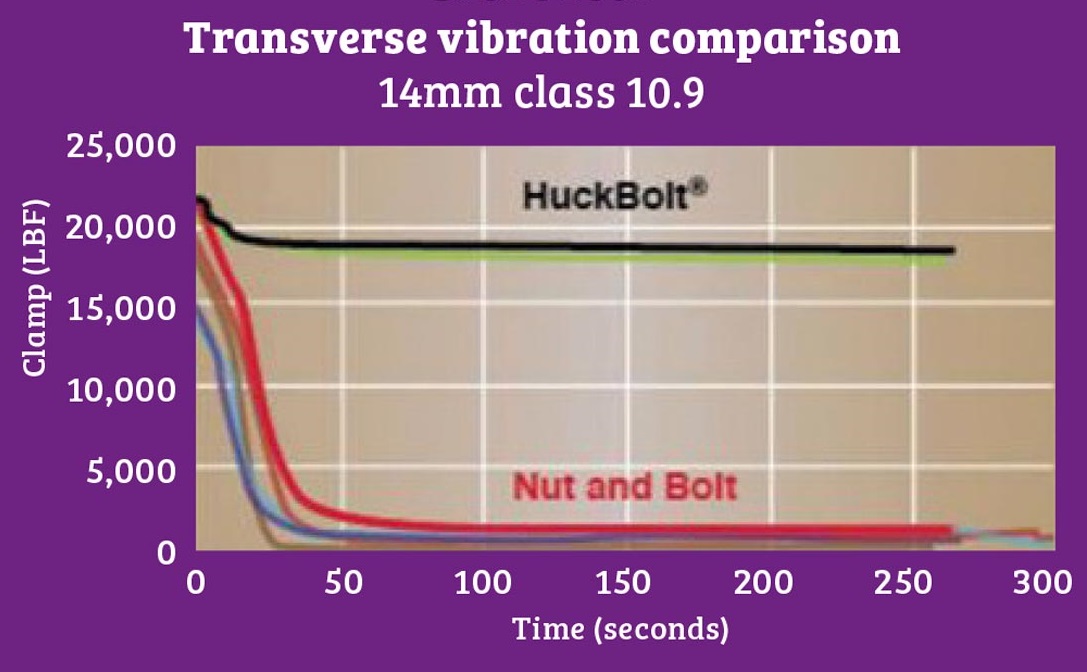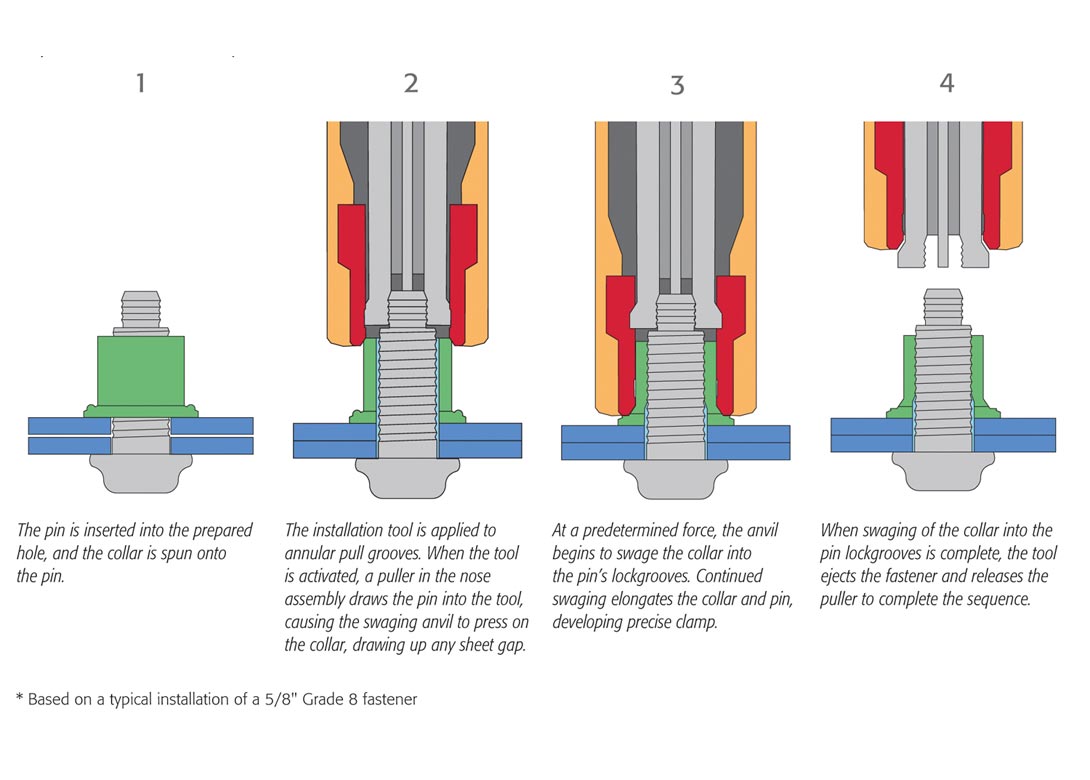
By Kirsti Hurne, marketing executive at Arconic Fastening Systems and Rings
For most heavy equipment applications, design engineers have focused on a stable, consistently tight joint for long-term durability and vibration resistance. At the same time, torque has long been the standard by which the tightness, and maybe even the overall integrity, of a joint is measured. This conventional thinking was based on the idea that the more power applied to a nut and bolt assembly in the form of torque, the tighter, more secure, and vibration resistant the joint. And as it turns out, like much conventional thinking, the belief that higher torque resulted in a more secure and durable joint was wrong.
Torque, as it relates to fasteners, is the twisting force required to spin a nut along the thread of a bolt. The basic formula for torque is T= (KDP)/12, where T= Torque in Foot Pounds, D= Nominal Diameter in Inches, P= Desire Clamp Load or Tension in Pounds, and K= Coefficient of Friction. The problem with this equation is that K is extremely hard to predict or measure, since it is impacted by a wide range of variables such as surface texture, oil, rust, debris, type of thread, material, and even humidity.
Another element in the joining equation, tension, is the stretch or elongation of a bolt that provides the clamp on the joint. A further explanation would define tension as the load on the joint brought about by drawing the fastener components together. Critical to the joining process, tension, is for the most part unrelated to torque. At best, torque is an indirect measurement of the tension applied to the bolt.
Clamp – the real measure of joint integrity
Clamp, defined as the load on the joint brought about by the drawing together of the fastener components, is virtually unrelated to torque. In fact, ongoing studies of clamp using sophisticated Skidmore-Wilhelm pre-load test equipment have clearly established that even when torque between two or more nuts and bolts is absolutely the same, the clamp value of these fasteners can vary more than 30% (Chart one). By comparison, a HuckBolt® lockbolt will vary 5% or less. This is an important point, given the fact that clamp is the critical element in joint integrity and durability.

Not only is clamp the true measurement of joint quality, it is critical to its long-term durability. If there is low or inconsistent clamp, a bolt can experience the very same service load as the joint. With a loose bolt, the cyclical loading is put on the bolt, which will subject it to fatigue. This pattern of failure usually occurs when there is high frequency loading, and often only several cycles are required to slowly propagate a crack across the cross-section of a bolt. The nut and bolt will either loosen or fail when the diminished cross-sectional area of the bolt is low enough to where it can no longer support the load.
Similarly, if there are several bolts in a joint and inconsistent clamp exists between them – some bolts having more than others – the outcome is going to be problematic. The bolts having more clamp will carry more of the service load. The bolts that are less clamped actually contribute little or nothing to the strength of the joint as compared to those exhibiting proper clamp. For instance, in an application where only three bolts out of six exhibit proper clamp, those three fasteners having proper clamp are forced to carry most of the load. Since the design of the joint calls for the use of six bolts, the joint is actually being supported by only three of the six bolts originally envisioned in the design. Because those three bolts are carrying most of the load designed for six bolts, they are highly prone to failure.
True clamp – not achievable through the application of torque
The dated belief system is that a nut and bolt are brought to consistent clamp via the following simplified process:
• The bolt or nut is torqued to prescribed torque value.
• The bolt is stretched.
• Desired clamp is achieved.
However, the process does not normally play out in such a predictable manner. The X factor is K, the coefficient of friction, being highly variable based on the many factors listed above. Based on the many variations of K, the following scenarios could play out after the bolt is torqued to the estimated value:
• The bolt may be stretched, but not to required length.
• The bolt may be over-stretched, exceeding its yield point.
• The tool output may not be accurate to the required torque setting.
These and many other unmanageable variables can, and will, create unpredictable results.
Direct tension fastening – the surest method for achieving consistent clamp
Today, many product engineers are moving away from conventional nuts and bolts fastening, with even various locking washers and nuts being seen as inadequate to provide the consistent clamp and secure locking needed for high vibration applications. Direct tensioned HuckBolts®, offered by Arconic Fastening Systems and Rings, are more often being utilised to provide both the reliability of consistent clamp, along with vibration resistance.
Structural HuckBolts, offered in a wide range of sizes (up to 36mm) and materials, have been proven in some of the most challenging equipment applications including heavy transportation, agriculture, and mining. Consisting of a pin and collar, these fasteners are installed via a direct tension technique, in which the pin is pulled and the collar is simultaneously swaged into the locking grooves of the pin. Based on their design and unique direct tension installation, HuckBolts deliver ultimately consistent clamp for a strong, long-term stable joint. A comparison of various fastener installation methods follows:

Eliminating the effects of vibration
In addition to providing for the most reliable clamp performance, there are several design elements of HuckBolts that also ensure their ultimate resistance to the effects of vibration. In conventional nut and bolt installations, gaps between the nut and bolt threads are universally encountered, providing the opportunity for loosening in high-vibration environments. By contrast, the Huck design, featuring the collar fully swaged into the locking grooves of the pin, creates no such problematic gap:

Instead of the deep threads required to achieve a tolerance fit between conventional nuts and bolts, the HuckBolt pin requires only shallow locking grooves into which the collar is swaged. The shallow design of the locking grooves allows for a much larger root radius, which contributes significantly to the fatigue strength – up to 5 times that of a conventional nut and bolt. Overall, a HuckBolt lockbolt provides superior vibration resistance as indicated by the study charted below:

Vibration resistance = Maintenance-free performance
As advanced Huck-brand fastening technology is proven to withstand the effects of vibration without ever loosening, HuckBolts never need to be inspected, tightened, or re-torqued. The benefits that accrue from this ability to withstand the effects of vibration are significant:
• One costly aspect of tower maintenance is eliminated, since there is no need to expend the manpower and time required to periodically inspect, tighten, and torque existing fasteners.
• In addition, a tower assembled with HuckBolts may never need to be taken off line for inspection and remediation of fasteners.
• Finally, by using vibration-resistant HuckBolts, the chance of a safety problem resulting from a failed fastener is virtually eliminated.
The unique vibration-resistant performance of HuckBolts is further confirmed by the fact that the BobTail® HuckBolt is the only fastener of its kind to be certified as maintenance-free by the prestigious DIBt Institute (12mm, 14mm, 16mm, 20mm, and 1 inch diameters). Based on this certification, one can now use the advanced BobTail, secure in the fact it meets the Institute’s high standards for both static and dynamic civil engineering applications.
The BobTail® – the HuckBolt for wind tower applications
The DIBt certified BobTail HuckBolt has proven its value in the fabrication of wind towers. In addition to proven vibration resistance, this advanced lockbolt fastener delivers 5x the fatigue strength of conventional nuts and bolts. The BobTail is available in sizes ranging from 10mm – 36mm, making it applicable to a wide range of wind tower-related fastening applications.Unlike conventional lockbolts, the BobTail does not require a pintail to be snapped off as part of the installation process, eliminating the potential issue of corrosion in the exposed pin break area. In addition, ergonomic BobTail tooling does not subject installation personnel to the constant jarring that occurs when a conventional lockbolt pintail snaps. Workers are much more productive, and certainly less prone to the kinds of repetitive stress issues that can result from the jarring that occurs when a pintail is snapped.
There are a number of other benefits associated with employing BobTail fasteners technologies in the fabrication of wind energy structures. Installation is fast and easy, and very little training is required for installation personnel. Additionally, all that is required to ensure that the fastener is accurately installed is a quick visual inspection.

Having spent a decade in the fastener industry experiencing every facet – from steel mills, fastener manufacturers, wholesalers, distributors, as well as machinery builders and plating + coating companies, Claire has developed an in-depth knowledge of all things fasteners.
Alongside visiting numerous companies, exhibitions and conferences around the world, Claire has also interviewed high profile figures – focusing on key topics impacting the sector and making sure readers stay up to date with the latest developments within the industry.






